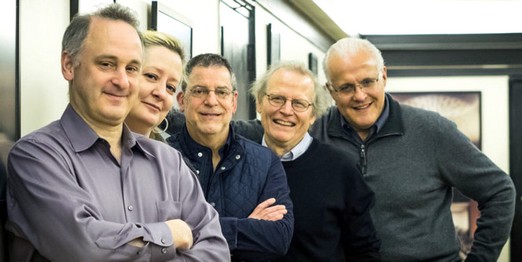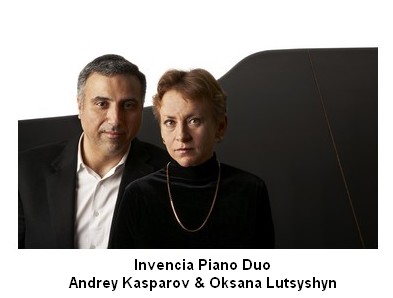
Reviews
Windscape returns!  Founded in 1994, Windscape is comprised of five wind instrumentalists at the top of their game: Tara Helen O’Connor on flute, Randall Ellis on oboe, Alan R. Kay on clarinet, Frank Morelli on bassoon, and David Jolley on horn. They are currently Artists-in-Residence at the Manhattan School of Music and give masterclasses and performances around the country. Dubbing themselves an “unquintet,” the ambitious group regularly takes on curious and provocative programming, making them a perfect match with the Norfolk Chamber Consort, which strives to introduce lesser known masterworks to Hampton Roads.  For the first half of this concert, Windscape paired with NCC Artistic Co-Directors Oksana Lutsyshyn and Andrey Kasparov in turn to present contrasting piano quintets by two composers written early on in their musical careers: Lowell Liebermann (b. 1961) and Ludwig van Beethoven (1770-1827). The concert opened with Liebermann’s riveting Fantasy on a Fugue by J.S. Bach, Op. 27 (1989), performed flawlessly by Windscape and pianist Oksana Lutsyshyn. Liebermann’s source material is the 24th (and final) fugue of Volume I of Bach’s Well-Tempered Clavier. The work was commissioned by NYC-based piano sextet (meaning wind quintet plus piano) Hexagon. Windscape’s clarinetist Alan R. Kay was a founding member of Hexagon and took part in the premiere of Liebermann’s work in 1989. In a discussion before the concert, Andrey Kasparov played Bach’s intense and chromatic fugue subject for the audience. Liebermann takes this nucleus and crafts free variations for his 10-minute virtuosic work. The work is bookended between a simple statement of the b minor fugue subject in the piano, while the variations are a wild roller coaster of sounds and colors: frenzied chase scenes, soft and introspective canons, angular tutti declarations, and more. Liebermann bridges the 250-year gap in a neo-romantic style, and the piece is so vivid it can almost be watched like a movie. Indeed, one could hear everything from Holst’s The Planets and Saint-Saëns’ Carnival of the Animals, to “Have Yourself a Merry Little Christmas,” to Ligeti, Sweeney Todd, and even Harry Potter. Lutsyshyn’s agile fingers flew across the keys, and the ensemble was completely attuned to one another. Next, Andrey Kasparov replaced Lutsyshyn at the piano to perform Ludwig van Beethoven’s Quintet in E-flat Major for Piano and Woodwinds, Op. 16 (1796-1797). The instrumentation of piano, oboe, clarinet, bassoon, and French horn mirrors Mozart’s own Quintet (K.452) composed 12 years prior. (Windscape performed Mozart’s masterwork with Kasparov during their previous engagement in Norfolk back in 2013: read M.D. Ridge’s review of the event here: https://www.artsongupdate.org/Reviews/NorfolkChamberConsort/NorfolkChamberConsort14.htm). A young Beethoven, age 26, took inspiration from his idol (whom he is purported to have met in Vienna in 1787) and utilized the same medium as a springboard for his own compositional ideas. Mozart’s influence is felt beyond the instrumentation and key signature, and shows in the thematic material, form, and the uncharacteristic levity from the often temperamental Beethoven. Perhaps it is the nature of wind instruments to instill good cheer around them! And yet, alongside these Mozartian influences are what would become unmistakable trademarks of Beethoven’s early and middle styles: passionate Sturm und Drang, a clear preference for motivic development over a surfeit of melodies, metric complexity and syncopated accents, and pushback against classical norms like established tonal conventions. In the third movement, the composer deliberately overlaps the entrance of the winds above the piano part between sections (cheerfully demonstrated to the audience by the performers before playing). In this chamber context, the effect is playful; however, the composer later employed a similar technique on a larger scale in his Third Symphony (“Eroica”), Op. 55. In a subversion of classical listeners’ expectations, the piece infamously caused a stir in rehearsal when it appeared that an unsuspecting horn soloist came in early in the wrong key. However, this was an intentional decision on the part of the composer. All the players let their creative spirits loose in this work. The woodwinds brought out tasteful touches, dove-tailing their melodies and employing stylish ornamentation. Through inventive use of the pedals and a refined touch on the keys, pianist Kasparov convinced the audience that he was playing not on a nine-foot Steinway concert grand but on an 18th-century fortepiano. In doing so, he was careful not to overpower the ensemble, and instead created a lush backdrop for all five performers to shape the music. It was hard to believe this was the same instrument that produced such Herculean sounds in the Liebermann! These artistic choices combined with the ensemble’s crisp articulations and vitality set Windscape and Kasparov’s performance of Beethoven’s Quintet above others. After a brief intermission, Windscape returned with flautist O’Connor for another pairing of past and present pieces, beginning with Mozart’s Adagio and Allegro in F Minor for Mechanical Organ, K.594 (1790), arranged for wind quintet by Israeli bassoonist and conductor Mordechai Rechtman (b. 1926). Rechtman’s arrangement shows that a wind quintet, with its plethora of options for articulations, dynamics, and shading, is the perfect conduit for Mozart’s musical ideas. The Adagio was yearning and heartfelt, while the ebullient Allegro evoked thoughts of spring and rebirth. The flute, oboe, and clarinet pass quick repeated notes between them, eventually going from the top to the very bottom of the ensemble; it was most impressive that the bassoon and horn precisely matched the rapid articulation of the smaller instruments. A deceptive cadence preceded a return to the Adagio, which lead to an extended episode filled with longing. The upper woodwinds cultivated beautiful, mellow sonorities on top of warm harmonies from the bassoon and horn. Last on the program was Jean Françaix’s (1912-1997) Wind Quintet No. 1 (1948). This lighthearted neoclassical work is comprised of four moderately short movements. Its sound world alternately suggested Stravinsky, Ligeti, Prokofiev, Bernstein, Schnittke, Copeland, and more. The first movement, I. Andante tranquillo — Allegro assai, begins with a slow, sultry introduction, then, heralded by rapid staccato double tonguing in the horn which reminded me of the tableaux changes in Stravinsky’s Petrouchka, takes off at light speed. Suddenly there are a bunch of toddlers running amok! The flute and oboe streak by in riotous scalar passages, the clarinet careens around in endless arpeggios, and the horn bawls for attention. And the oblivious babysitter, the bassoon, bounces around, unconcerned. Windscape made the insanity sound effortless. The second movement, II. Presto, felt like a wild taxi ride — car horns, jaywalking pedestrians, drunkards, and aloof celebrities included. The contrasting B section is a slow, funky waltz, as if Johann Strauss, Jr. and Bernstein had a love child. Clarinetist Kay takes on the role of the jaded pedestrian with bluesy solos. Abruptly the Presto tempo returns, even faster, because why not? It’s rush hour! Everyone hurtles about. Not to be outdone, the drunken waltz comes back, more melancholic. Cheekily, the Presto returns for a final utterance — maybe the cab rushed into a free parking space. The third movement is a set of variations on Françaix’s own theme; however, the work doesn’t begin like a typical theme and variations, which normally start simply and gradually become more complicated. Instead, the initial statement is quite intricate and perplexing. As the piece progresses, the listener gradually discovers the theme in reverse. The first variation had solo instruments layer their lines over a leaping bass. Next was a harmonic variation in canon; the flute and horn overtones gave the impression of coloring the notes like organ stops. Here all five instrumentalists showcased their superb expression and control. The ending variation is slow and reticent. By the end of the movement, a listener might still be unsure what the original theme had been, but perhaps had gained an intuitive understanding. The show-stopping IV. Tempo di marcia francese evoked more feelings of Stravinsky (this time his Symphony of Psalms) and Prokofiev’s Peter and the Wolf, by virtue of the entertaining characterizations of each instrument. Audience members couldn’t help but stifle giggles in the comedic march as the horn took on a somewhat...flatulent character. Even more impressive were horn player David Jolley’s pristine, mile-wide arpeggios. My concert companion (himself a brass specialist) and I watched in disbelief as Jolley did the miraculous. Spurred on by the audience’s enthusiastic reception to a far-reaching night of virtuosity and expertise, Windscape returned with a lyrical, jazzy encore from Bernstein’s one-act opera, Trouble in Tahiti (1951). As described by the instrumentalists, the Prelude is sung by three elegant gentlemen describing an idyllic suburban life (soon proving to have been tongue-in-cheek in the context of the opera.) It was fitting to end with a tribute to Bernstein, as his presence was felt throughout the entire program. The specter of Bernstein, especially his stamp on composing for winds, lives on through the American musical consciousness*. Is it any wonder that this New York-based group exuded the energy of Bernstein at every turn, even while playing Beethoven and Mozart? Back to Top
|